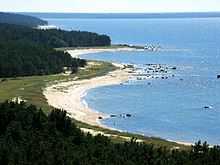Hiiumaa
 Tahkuna peninsula is the most northern part of Hiiumaa | |
.jpg) | |
| Geography | |
|---|---|
| Location | Baltic Sea |
| Coordinates | Coordinates: 58°52′N 22°35′E / 58.867°N 22.583°E |
| Archipelago | West Estonian archipelago |
| Area | 989 km2 (382 sq mi) |
| Highest elevation | 68 m (223 ft) |
| Highest point | Tornimägi |
| Country | |
|
Estonia | |
| County | Hiiu County |
| Largest settlement | Kärdla (pop. 3,287 (01.01.2012)[1]) |
| Demographics | |
| Population | 9,181 |
Hiiumaa (Estonian pronunciation: [ˈhiːumɑː]) is the second largest island (989 km²) belonging to Estonia. It is located in the Baltic Sea, north of the island of Saaremaa, a part of the West Estonian archipelago. Its largest town is Kärdla.
Name
Hiiumaa is the main island of Hiiu County, called Hiiumaa or Hiiu maakond in Estonian. The Swedish and German name of the island is Dagö (day island), Dagø in Danish — a calque of its old Finnish name Päivänsalo (day island); compare Ösel (Yösalo – night island) for Saaremaa. In modern Finnish it is called Hiidenmaa, literally hiisi's land. In Old Gutnish it was Dagaiþ (day isthmus), from which the local North Germanic name "Daë" is derived.
History
Archaeological evidence of the first human settlement in Hiiumaa dates to as early as the 4th century BC. The first documented record of the island of Dageida was made by contemporary chroniclers in 1228, at the time when Hiiumaa, along with the rest of Estonia, had been conquered by Germanic crusaders. In 1254, Hiiumaa was divided between the Bishopric of Ösel-Wiek and the Livonian branch of the Teutonic Order, who were also partly acting on behalf of the Hanseatic League.

The island was part of Swedish Estonia from 1563 to 1721, after which it passed to the Russian Empire as part of the Governorate of Estonia, although Dagö's Swedish population kept most of their privileges. Most of the island's previously numerous Swedish-speaking population emigrated or were "Estonianised" during the period of Imperial Russian rule, although a small minority remains to this day. Estonian Swedes are also known as "aibofolke" (meaning island people in Swedish) or "rannarootslased" (meaning coastal Swedes in Estonian).
World War I
Hiiumaa was occupied during World War I by the Imperial German Army, in Operation Albion. After the war, it became a part of independent Estonia.
World War II
It was annexed by the Soviet Union in 1940, by Nazi Germany in 1941, and by the Soviets again in 1944. It was then a part of the Estonian Soviet Socialist Republic until the Soviet Union's collapse in 1991. During the Soviet era Hiiumaa was declared a restricted zone, closed to foreigners and to most mainland Estonians. Since 1991, the island has been a part of independent Estonia.
Some maritime activities did happen near the waters of Hiiumaa. The Soviet destroyer Gnevny was sunk 23 June 1941 after having hit a German seamine. Two German motor torpedo boats, S43 and S106, were destroyed because of the Soviet seamines, 27 June 1941. To the north of Hiiumaa, on 1 July 1941, the Soviet submarine M-81 was destroyed because of a German seamine. On the Hiiumaa waters itself again on 25 June, the Soviet minesweeper T-208 Shkiv was hit with a German seamine and was destroyed. The same happened to the Soviet minesweepers T-216, on 7 July 1941 and T-201 Zarjad, on 30 July 1941. Also the Soviet submarine, SC-307, fired a torpedo at the German submarine U-144, which sank, 10 August 1941.[2]
Transport
Road transport from Estonian mainland to Hiiumaa involves a 90-minute (28 km) ferry crossing from Rohuküla to Heltermaa, which is 25 km by road from Kärdla. There are about 10 ferry departures a day.[3] In the summer weekends, getting car space on the ferry usually requires advance booking. There are about 2 scheduled buses a day between Tallinn (the capital of Estonia) and Kärdla.[4] In the winter, the island can be reached, conditions permitting, via a 26.5 km ice road (the longest in Europe) across the frozen Baltic Sea.[5][6]
Hiiumaa is served by Kärdla Airport, with regular flights to Tallinn. Bicycle rental is also available in Kärdla and there is a good bicycle path built from Kärdla towards Kõrgessaare.
Notables
- Aleksander Maaker (1880-1968), the last traditional player of the torupill (Estonian bagpipe)
- Lydia Mei (1896 - 1965), Estonian artist.
- Roman von Ungern-Sternberg (1885-1921), White military commander in the Russian Civil War.
Gallery
-

Tahkuna lighthouse -
Church of Kassari -
Old farmhouse -
Sõru museum -

Malvaste chapel -

Cars boarding the ferry to mainland at Heltermaa
-

Coast of Hiiumaa
-

Tubala windmill
-

Avenue at Suuremõisa Park
See also
References
- ↑ Comparison of self-government units, Statistical Council's Regional Portal (checked November 7th, 2012)
- ↑ Jorma Mäntykoski, Kalevi Keskinen (1991). The Finnish Navy At War in 1939-1945 (Suomen Laivasto Sodassa 1939-1945). Espoo: Tietoteos Ky. p. 154. ISBN 951-8919-05-4.
- ↑ "Ferry schedules and booking". Tuulelaevad.
- ↑ "Bus schedules and booking". BussiReisid.
- ↑ Estonia claims Europe's longest ice highway. The Independent. 19 February 2011. Retrieved 19 February 2011.
- ↑ "BBC: No seatbelts allowed on Europe's longest ice road". Retrieved 18 February 2014.
External links
| Wikivoyage has a travel guide for Hiiumaa. |
 Media related to Hiiumaa at Wikimedia Commons
Media related to Hiiumaa at Wikimedia Commons- Hiiumaa County government Official site
- Hiiumaa at DMOZ
- Pictures of Coastal batteries World War I and World War II in Hiiumaa Official site
| ||||||||||||||||||||||||||||||


